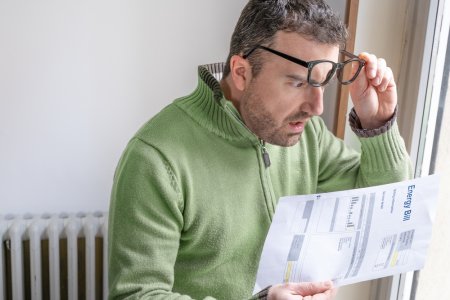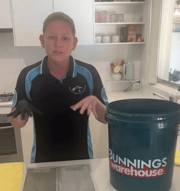Are soaring power bills emptying your wallet this winter? Learn why they're suddenly spiking and what you can do about it!
- Replies 5
We all know how nerve-wracking it can be when the time comes to open the power bill—it’s a bit like that moment when you draw back the shower curtain and brace yourself for an icy blast of cold air. Only this time, it’s less about the cold air and more about empty wallets and the multitude of zeros at the end of the bill.
Snug and cosy homes are an Australian winter tradition, but this year our heaters' warmth seems to be melting away more than just the chill. According to comparison website Finder, power bills have been surging, leaving a hole of up to $800 in some Aussie households’ pockets.
'Wait, what?' we hear you say, 'That's outrageous!'
Quite right! The majority of us, a whopping 79 per cent, in fact, had planned to cut back on electricity usage during winter to save a few dollars. Yet, Finder’s sobering statistic reveals that many are still being hit with larger bills than they were in the preceding year.

'Millions of Aussies need a reprieve and are taking matters into their own hands by cutting their usage,' asserts energy expert Mariam Gabaji from Finder. However, relief seems to be scant.
Power retailers aren’t easing the pain. As Gabaji has highlighted, some are even sending out notices about massive increases to their power rates, leaving customers in a state of wide-eyed ‘bill shock’.
This new rate hike epidemic doesn’t discriminate, nor is it isolated to a particular region. South Australians hold the unlucky title of the highest power bill climbers, facing an eye-watering jump of between 22 and 63 per cent on their yearly estimates.
In other parts of the country, New South Wales bills are predicted to rise by 15 to 36 per cent, and our Victorian and Queenslander friends aren’t far behind, facing bill hikes of 22 to 31 per cent and eight to 41 per cent, respectively.
In an attempt to thwart the growing costs, Finder’s survey showed that 56 per cent of us plan to switch off lights and power points when not in use, while 54 per cent of us will adjust the temperature on the heater or air-con. Nine per cent will even forgo working from home, heading back to the office to reduce their energy usage at home.
So, what are our options? Well, Gabaji suggests switching to a cheaper energy plan is one way to safeguard ourselves.
'Make sure you're on one of the cheapest plans and switch again in six to 12 months if you find a better deal,' she advised.

She urges us to be proactive and not just settle for the status quo—contact the retailer, negotiate a cheaper deal, and shop around and compare* to see if we can do even better with another provider.
In addition, she recommended checking if you're eligible for government bill relief and, in cases of 'extreme difficulty', reaching out to your retailer about their hardship program. The exact nature of the available concessions will depend on your state, energy provider, and your particular circumstances, but here’s some information to get you started.
Have you got any tips for reducing your energy bill? Share them with us in the comments below.
Snug and cosy homes are an Australian winter tradition, but this year our heaters' warmth seems to be melting away more than just the chill. According to comparison website Finder, power bills have been surging, leaving a hole of up to $800 in some Aussie households’ pockets.
'Wait, what?' we hear you say, 'That's outrageous!'
Quite right! The majority of us, a whopping 79 per cent, in fact, had planned to cut back on electricity usage during winter to save a few dollars. Yet, Finder’s sobering statistic reveals that many are still being hit with larger bills than they were in the preceding year.

Energy bills are spiking all across the country, causing many to choose between 'heating' and 'eating'. Source: Shutterstock
'Millions of Aussies need a reprieve and are taking matters into their own hands by cutting their usage,' asserts energy expert Mariam Gabaji from Finder. However, relief seems to be scant.
Power retailers aren’t easing the pain. As Gabaji has highlighted, some are even sending out notices about massive increases to their power rates, leaving customers in a state of wide-eyed ‘bill shock’.
This new rate hike epidemic doesn’t discriminate, nor is it isolated to a particular region. South Australians hold the unlucky title of the highest power bill climbers, facing an eye-watering jump of between 22 and 63 per cent on their yearly estimates.
In other parts of the country, New South Wales bills are predicted to rise by 15 to 36 per cent, and our Victorian and Queenslander friends aren’t far behind, facing bill hikes of 22 to 31 per cent and eight to 41 per cent, respectively.
In an attempt to thwart the growing costs, Finder’s survey showed that 56 per cent of us plan to switch off lights and power points when not in use, while 54 per cent of us will adjust the temperature on the heater or air-con. Nine per cent will even forgo working from home, heading back to the office to reduce their energy usage at home.
So, what are our options? Well, Gabaji suggests switching to a cheaper energy plan is one way to safeguard ourselves.
'Make sure you're on one of the cheapest plans and switch again in six to 12 months if you find a better deal,' she advised.
Key Takeaways
- Many Australian households are facing power bill increases of up to $800 as a result of increased energy use in winter.
- A survey from comparison website Finder showed that 79 per cent of Australians plan to reduce electricity usage to manage the higher costs.
- South Australians are expected to see the biggest price rises, with some residential households expecting an increase of between 22 per cent and 63 per cent.
- Options to manage higher utility costs include switching to a cheaper energy plan, negotiating lower rates with current providers, and applying for government bill relief.
In addition, she recommended checking if you're eligible for government bill relief and, in cases of 'extreme difficulty', reaching out to your retailer about their hardship program. The exact nature of the available concessions will depend on your state, energy provider, and your particular circumstances, but here’s some information to get you started.
Have you got any tips for reducing your energy bill? Share them with us in the comments below.







